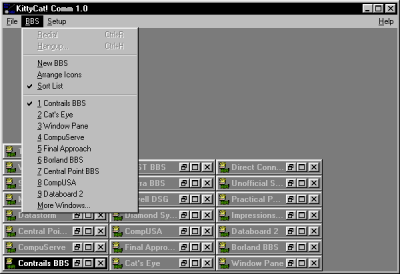KittyCat! Comm: Difference between revisions
No edit summary |
|||
| Line 1: | Line 1: | ||
[[Image:KittyCatComm-About.png|right|thumb|350px|The "about" window in KittyCat! Comm 1.0. Clicking on the cat picture causes the window to "meow" on systems with audio capabilities]] KittyCat! Comm was a [http://en.wikipedia.org/wiki/Bulletin_board_system bulletin board system (BBS)] communication program for [http://en.wikipedia.org/wiki/Windows_3.1 Windows 3.1] with ambitious plans. The vision was to support traditional text-based BBS systems and [http://en.wikipedia.org/wiki/Remote_imaging_protocol RIPscrip graphics] along with arbitrary data exchange between remote programs and BBS-driven [[SLOS-DOS|SLOS scripting]]. This project was abandoned shortly after I started using the [http://en.wikipedia.org/wiki/Internet Internet] and [http://en.wikipedia.org/wiki/Internet_protocol_suite TCP/IP]; they made KittyCat! Comm obsolete. | [[Image:KittyCatComm-About.png|right|thumb|350px|The "about" window in KittyCat! Comm 1.0. Clicking on the cat picture causes the window to "meow" on systems with audio capabilities]] KittyCat! Comm was a [http://en.wikipedia.org/wiki/Bulletin_board_system bulletin board system (BBS)] communication program for [http://en.wikipedia.org/wiki/Windows_3.1 Windows 3.1] with ambitious plans. The vision was to support traditional text-based BBS systems and [http://en.wikipedia.org/wiki/Remote_imaging_protocol RIPscrip graphics] along with arbitrary data exchange between remote programs and BBS-driven [[SLOS-DOS|SLOS scripting]]. This project was abandoned shortly after I started using the [http://en.wikipedia.org/wiki/Internet Internet] and [http://en.wikipedia.org/wiki/Internet_protocol_suite TCP/IP]; they made KittyCat! Comm obsolete. | ||
The implementation supports multiple telephone numbers per BBS, inter-program communication using the [http://en.wikipedia.org/wiki/Dynamic_Data_Exchange dynamic data exchange (DDE)] mechanism in [http://en.wikipedia.org/wiki/Microsoft_Windows Windows], [http://en.wikipedia.org/wiki/ANSI_escape_code ANSI text] and [http://en.wikipedia.org/wiki/Remote_imaging_protocol RIPscrip graphics] rendering in its console, and a partially-implemented MeowModem file transfer program. Almost every part of the system has [http://en.wikipedia.org/wiki/Cat cat]-themed names, such as its KittyDDE application programming interface (API). | The implementation supports multiple telephone numbers per BBS, inter-program communication using the [http://en.wikipedia.org/wiki/Dynamic_Data_Exchange dynamic data exchange (DDE)] mechanism in [http://en.wikipedia.org/wiki/Microsoft_Windows Windows], [http://en.wikipedia.org/wiki/ANSI_escape_code ANSI text] and [http://en.wikipedia.org/wiki/Remote_imaging_protocol RIPscrip graphics] rendering in its console, and a partially-implemented MeowModem file transfer program. Almost every part of the system has [http://en.wikipedia.org/wiki/Cat cat]-themed names, such as its KittyDDE [http://en.wikipedia.org/wiki/Application_programming_interface application programming interface (API)]. | ||
==Download== | ==Download== | ||
Revision as of 19:03, 13 October 2007
KittyCat! Comm was a bulletin board system (BBS) communication program for Windows 3.1 with ambitious plans. The vision was to support traditional text-based BBS systems and RIPscrip graphics along with arbitrary data exchange between remote programs and BBS-driven SLOS scripting. This project was abandoned shortly after I started using the Internet and TCP/IP; they made KittyCat! Comm obsolete.
The implementation supports multiple telephone numbers per BBS, inter-program communication using the dynamic data exchange (DDE) mechanism in Windows, ANSI text and RIPscrip graphics rendering in its console, and a partially-implemented MeowModem file transfer program. Almost every part of the system has cat-themed names, such as its KittyDDE application programming interface (API).
Download
- Download KittyCat! Comm and its source code
- Download the KittyCat! Comm installer, which does not appear to work properly in Windows XP and Wine. Download the zip file instead unless if you are using Windows 3.1
Dialing Directory
The dialing directory was implemented using minimized multiple document interface (MDI) windows, which appear as icons with a title underneath on Windows 3.1. This was meant to make BBSes appear as programs as they did in the Windows Program Manager. In Windows 95 and later versions, minimized MDI windows appear as small title bars with control icons, making the dialing directory's user interface appear drastically different.
 The dialing directory as it appears on a Windows 95 system |
|
Terminal Console
The terminal console appears after a successful connection to a BBS is made. It can also be launched while KittyCat! Comm is not running, which puts the console into local-echo mode. Support for ANSI and partial support for RIPscrip exists in the implementation, though Zmodem file transfer support was never finished.
 Console preferences dialog box. The default 20-color palette in Windows 3.1 did not include a good brown color, so this console implements its own in its palette and calls it TrueBrown | |








